Colorimetric Properties and Classification of “Tang yu”
Abstract
1. Introduction
2. Materials and Methods
2.1. Materials
2.2. Methods
2.2.1. UV-Vis Spectroscopy
2.2.2. X-Ray Fluorescence
2.2.3. CIE1976 L*a*b* Uniform Color Space System
2.2.4. Colorimetric Analysis
3. Results and Discussion
3.1. Chemical Analysis
3.2. UV-Vis-NIR Spectroscopy
3.3. Color Quantification
3.3.1. Effect of Various Light Sources on Color Perception
3.3.2. Effect of Various Polishing Methods on Color Perception
3.3.3. Effect of Various the Backgrounds on Color Perception
3.4. Color Grading of “Tang yu”
4. Conclusions
Author Contributions
Funding
Data Availability Statement
Acknowledgments
Conflicts of Interest
Abbreviations
| L* | Lightness |
| a* | Color parameter a* |
| b* | Color parameter b* |
| C* | Chroma C* |
| h° | Hue angle h° |
| γb | Luminance factor γb |
References
- Wang, R. Review on the mechanism of whitening of excavated ancient nephrite jade artifacts in China. Sci. Conserv. Archaeol. 2017, 29, 88–100. [Google Scholar]
- Yu, H.Y.; Ruan, Q.F.; Sun, Y.; Li, D.S. Micro-morphology and Mineral Composition of Different Color Qinghai Nephrites. Rock Miner. Anal. 2018, 37, 626–636. [Google Scholar]
- Zhang, X.H.; Feng, Y.H.; Zhang, Y.; Maituohuti, A. Analysis of Yelow-Green Hetian Jade in Qiemo—Ruoqiang Area, Xinjiang and Characterization. Rock Miner. Anal. 2022, 41, 586–597. [Google Scholar]
- Bao, Y.; Ye, X.H.; Xin, J.M.; Zhang, J.H.; Yuan, J.; Zheng, J.M.; Zhu, Q.W. Scientific Analysis and Related Issues of the Jade Artifacts Unearthed from the Tomb of Guo Zhong. Cult. Relics 2023, 4, 72–85. [Google Scholar]
- Jiang, B.H.; Bai, F.; Zhao, J.K. Mineralogical and geochemical characteristics of green nephrite from Kutcho, northern British Columbia, Canada. Lithos 2021, 388, 106030. [Google Scholar] [CrossRef]
- Fu, X.F.; Gan, F.X.; Ma, B.; Gu, D.H. Structural and nondestructive componential analysis on several nephrite from different provenances. Acta Petrol. Sin. 2007, 23, 1197–1202. [Google Scholar]
- Zhang, Y.W.; Liu, Y.; LIU, T.T.; Zari, M.; Liu, Y.Q. Vibrational Spectra of Hetian Nephrite from Xinjiang. Spectrosc. Spectr. Anal. 2012, 32, 398–401. [Google Scholar]
- Liu, Y.; Deng, J.; Shi, G.H.; Yui, T.F.; Zhang, G.B.; Abuduwayiti, M.; Yang, L.Q.; Sun, X. Geochemistry and petrology of nephrite from Alamas, Xinjiang, NW China. J. Asian Earth Sci. 2011, 42, 440–451. [Google Scholar] [CrossRef]
- Wang, J.X.; Shi, G.H. Comparative study on the origin and characteristics of Chinese (Manas) and Russian (East Sayan) green nephrites. Minerals 2021, 11, 1434. [Google Scholar] [CrossRef]
- Wilkins, C.J.; Tennant, W.C.; Williamson, B.E.; McCammon, C.A. Spectroscopic and related evidence on the coloring and constitution of New Zealand jade. Am. Mineral. 2003, 88, 1336–1344. [Google Scholar] [CrossRef]
- Adams, C.J.; Beck, R.J.; Campbell, H.J. Characterisation and origin of New Zealand nephrite jade using its strontium isotopic signature. Lithos 2007, 97, 307–322. [Google Scholar] [CrossRef]
- Grapes, R.H.; Yun, S.T. Geochemistry of a New Zealand nephrite weathering rind. N. Z. J. Geol. Geophys. 2010, 53, 413–426. [Google Scholar] [CrossRef]
- Cooper, A.F. Origin and evolution of nephrites, diopsidites and giant diopside crystals from the contact zones of the Pounamu Ultramafics, Westland, New Zealand. N. Z. J. Geol. Geophys. 2023, 66, 88–101. [Google Scholar] [CrossRef]
- Hemantha Kumar, G.N.; Parthasarathy, G.; Chakradhar, R.P.S.; Lakshmana Rao, J.; Ratnakaram, Y.C. Temperature dependence on the electron paramagnetic resonance spectra of natural jasper from Taroko Gorge (Taiwan). Phys. Chem. Miner. 2010, 37, 201–208. [Google Scholar] [CrossRef]
- Li, N.; Bai, F.; Peng, Q.; Liu, M.S. Geochemical characteristics of nephrite from Chuncheon, South Korea: Implications for geographic origin determination of nephrite from dolomite-related deposits. Crystals 2023, 13, 1468. [Google Scholar] [CrossRef]
- Feng, Y.H.; He, X.M.; Jing, Y.T. A new model for the formation of nephrite deposits: A case study of the Chuncheon nephrite deposit, South Korea. Ore Geol. Rev. 2022, 141, 104655. [Google Scholar] [CrossRef]
- Yui, T.F.; Kwon, S.T. Origin of a dolomite-related jade deposit at Chuncheon, Korea. Econ. Geol. 2002, 97, 593–601. [Google Scholar] [CrossRef]
- Gil, G.; Bagiński, B.; Gunia, P.; Madej, S.; Sachanbiński, M.; Jokubauskas, P.; Belka, Z. Comparative Fe and Sr isotope study of nephrite deposits hosted in dolomitic marbles and serpentinites from the Sudetes, SW Poland: Implications for Fe-As-Au-bearing skarn formation and post-obduction evolution of the oceanic lithosphere. Ore Geol. Rev. 2020, 118, 103335. [Google Scholar] [CrossRef]
- Siqin, B.; Qian, R.; Zhuo, S.J.; Gan, F.X.; Dong, M.; Hua, Y.F. Glow discharge mass spectrometry studies on nephrite minerals formed by different metallogenic mechanisms and geological environments. Int. J. Mass Spectrom. 2012, 309, 206–211. [Google Scholar] [CrossRef]
- Jutras, J.P.; Williams, B.; Williams, C.; Ream, L. Nephrite Jade from the Sky Zone, Wyoming, USA: Characteristics and Primary Hydrothermal Origin. J. Gemmol. 2024, 39, 36–53. [Google Scholar] [CrossRef]
- Wang, S.Q.; Duan, T.Y.; Zheng, Z.Z. Mineralogical and petrological characteristics of Xiuyan nephrite and its minerogenetic model. Acta Petrol. Mineral. 2002, 21, 79–90. [Google Scholar]
- Liu, Y.C.; Zhou, Z.Y.; Yang, X.Y.; Chen, Y.Y.; Ruan, W.D.; Zhang, L.M. Study on difference of color genesis between yellow and brown tremolite jade. Acta Petrol. Mineral. 2021, 40, 1189–1196. [Google Scholar]
- Han, W.; Hong, H.L.; Wu, Y.; Yin, K. Color Genesis of Brown Jade from Hetian Nephrite. Spectrosc. Spectr. Anal. 2013, 33, 1446–1450. [Google Scholar]
- Liu, Y.; Shigley, J.; Fritsch, E.; Hemphill, S. The “alexandrite effect” in gemstones. Color Res. Appl. 1994, 19, 186–191. [Google Scholar] [CrossRef]
- Tang, J.; Guo, Y.; Xu, C. Metameric effects on peridot by changing background color. J. Opt. Soc. Am. A Opt. Image Sci. Vis. 2019, 36, 2030–2039. [Google Scholar] [CrossRef] [PubMed]
- Li, C.J.; Li, Z.Q.; Wang, Z.F.; Xu, Y.; Luo, M.R.; Cui, G.H.; Manuel, M.; Brill, M.H.; Michael, P. Comprehensive color solutions: CAM16, CAT16, and CAM16-UCS. Color Res. Appl. 2017, 42, 703–718. [Google Scholar] [CrossRef]
- GB/T 20146-2006; CIE Standard Illuminants for Colorimetry. General Administration of Quality Supervision, Inspection and Quarantine of the People’s Republic of China & National Standardization Administration: Beijing, China, 2006.
- Guo, Y.; Wang, H.; Li, X.; Dong, S.R. Metamerism Appreciation of Jadeite-Jade Green under the Standard Light Sources D 65, A and CWF. Acta Geol. Sin. 2016, 90, 2097–2103. [Google Scholar] [CrossRef]
- Sun, Z.; Palke, A.C.; Renfro, N. Vanadium- and Chromium-Bearing Pink Pyrope Garnet: Characterization and Quantitative Colorimetric Analysis. Gems Gemol. 2016, 51, 348–369. [Google Scholar] [CrossRef]
- Han, J.Y.; Guo, Y.; Liu, S.T. Environmental issues on color quality evaluation of blue sapphire based on gemdialogueTM color comparison charts. Ekoloji Derg. 2018, 27, 1365–1376. [Google Scholar]
- Mangine, H.; Jakes, K.; Noel, C. A preliminary comparison of CIE color differences to textile color acceptability using average observers. Color Res. Appl. 2005, 30, 288–294. [Google Scholar] [CrossRef]
- Perez, M.D.M.; Ghinea, R.; Herrera, L.J.; Ionescu, A.M.; Pomares, H.; Pulgar, R.; Paravina, R.D. Dental ceramics: A CIEDE2000 acceptability thresholds for lightness, chroma and hue differences. J. Dent. 2011, 39, e37–e44. [Google Scholar] [CrossRef] [PubMed]
- Zhang, Y. Mineralogical Study on Nephrite from No. 7 Deposit, QieMo, Xinjiang. Master’s Thesis, China University of Geosciences, Beijing, China, 2019. [Google Scholar]
- Gao, K. Study on the Metallogenic Mechanism of Tashisayi Nephrite from Xinjiang. Ph.D. Thesis, China University of Geosciences, Beijing China, 2018. [Google Scholar]
- Torrent, J.; Barrón, V. Diffuse reflectance spectroscopy of inron oxides. Encycl. Surf. Colloid Sci. 2002, 1, 1438–1446. [Google Scholar]
- Ding, J.; Xue, Q.F. Ultraviolet-Visible Absorption Spectra Representation of Yellow Sapphire from Shandong Province in China. Superhard Mater. Eng. 2005, 2, 57–60. [Google Scholar]
- Li, X.X. The color causes and spectroscopy characteristics of sapphire from Shandong ChangLe. J. Grad. Sun Yat-Sen Univ. (Nat. Sci. Med.) 2015, 36, 60–73. [Google Scholar]
- Pan, Z.L. Reference Collection for Teaching Crystallography and Mineralogy, 1st ed.; Higher Education Press: Beijing, China, 1982; pp. 48–49. [Google Scholar]
- Dai, J.; Sun, C.M.; Xie, Y.S.; Zhou, R.B. Spectroscopy and Coloration Mechanism for Myanmar Jadeite Jade. Acta Geol. Sichuan 2007, 27, 296–300. [Google Scholar]
- Wang, C.B.; Yuan, X.Q.; Lei, T.; Zheng, Y.L. Gemmological Characteristic of “Anthophylite Jade” from Xinjiang, China. J. Gems Gemmol. 2018, 20, 37–45. [Google Scholar]
- Yu, H.Y. Coloring and Metallogenic Mechanisms of Different Colors in Qinghai Nephrite. Ph.D. Thesis, Nanjing University, Nanjing, China, 2016. [Google Scholar]
- Taran, M.N.; Monika, K.M.; Langer, K. Electronic absorption spectroscopy of natural (Fe2+, Fe3+)-bearing spinels of spinel s.s.-hercynite and gahnite-hercynite solid solutions at different temperatures and high-pressures. Phys. Chem. Miner. 2005, 32, 175–188. [Google Scholar] [CrossRef]
- Sargolzaei, M.; Samaneh Ataee, S. First principles study on spin and orbital magnetism of 3d transition metal monatomic nanowires (Mn, Fe and Co). J. Phys. Condens. Matter 2011, 23, 125301. [Google Scholar] [CrossRef]
- Wang, J.W.; Wang, Y.Q.; Feng, Q.; Wu, X.Y.; Chen, J.X. Analysis and Identification of Cobalt Latice Difused Vietnam Spinel by Using UV-Vis-NIR Spectroscopy. J. East China Univ. Sci. Technol. (Nat. Sci. Ed.) 2018, 44, 839–844. [Google Scholar]
- Yuan, X.Q.; Qi, L.J.; Du, G.P.; Chen, X.Y. UV-VIS-NIR Spectrum of Jadeite Jade from Burma. J. Gems Gemmol. 2003, 5, 11–16. [Google Scholar]
- Lam, Y.M.; Xin, J.H. Evaluation of the quality of different D65 simulators for visual assessment. Color Res. Appl. 2002, 27, 243–251. [Google Scholar] [CrossRef]
- Simonot, L.; Hébert, M. Between additive and subtractive color mixings: Intermediate mixing models. J. Opt. Soc. Am. A 2013, 31, 58–66. [Google Scholar] [CrossRef] [PubMed]
- Coates, A.; Ng, A.Y. Learning feature representations with k-means. In Neural Networks: Tricks of the Trade, 2nd ed.; Montavon, G., Orr, G.B., Müller, K.R., Eds.; Lecture Notes in Computer Science 7700; Springer: Berlin/Heidelberg, Germany, 2012; ISBN 978-3-642-35288-1. [Google Scholar]
- Guo, Y.; Zong, X.; Qi, M. Feasibility Study on Quality Evaluation of Jadeite-Jade Color Green Based on GemDialogue Color Chip. Multimed. Tools Appl. 2019, 78, 841–856. [Google Scholar] [CrossRef]
- Liu, H.X.; Wu, B.; Liu, Y.; Huang, M.; Xu, Y.F. A Discussion on Printing Color Difference Tolerance by CIEDE2000 Color Difference Formula. Appl. Mech. Mater. 2012, 262, 96–99. [Google Scholar] [CrossRef]
- GB/T 23885-2009; Jadeite Grading. General Administration of Quality Supervision, Inspection and Quarantine of the People’s Republic of China &National Standardization Administration: Beijing, China, 2009.

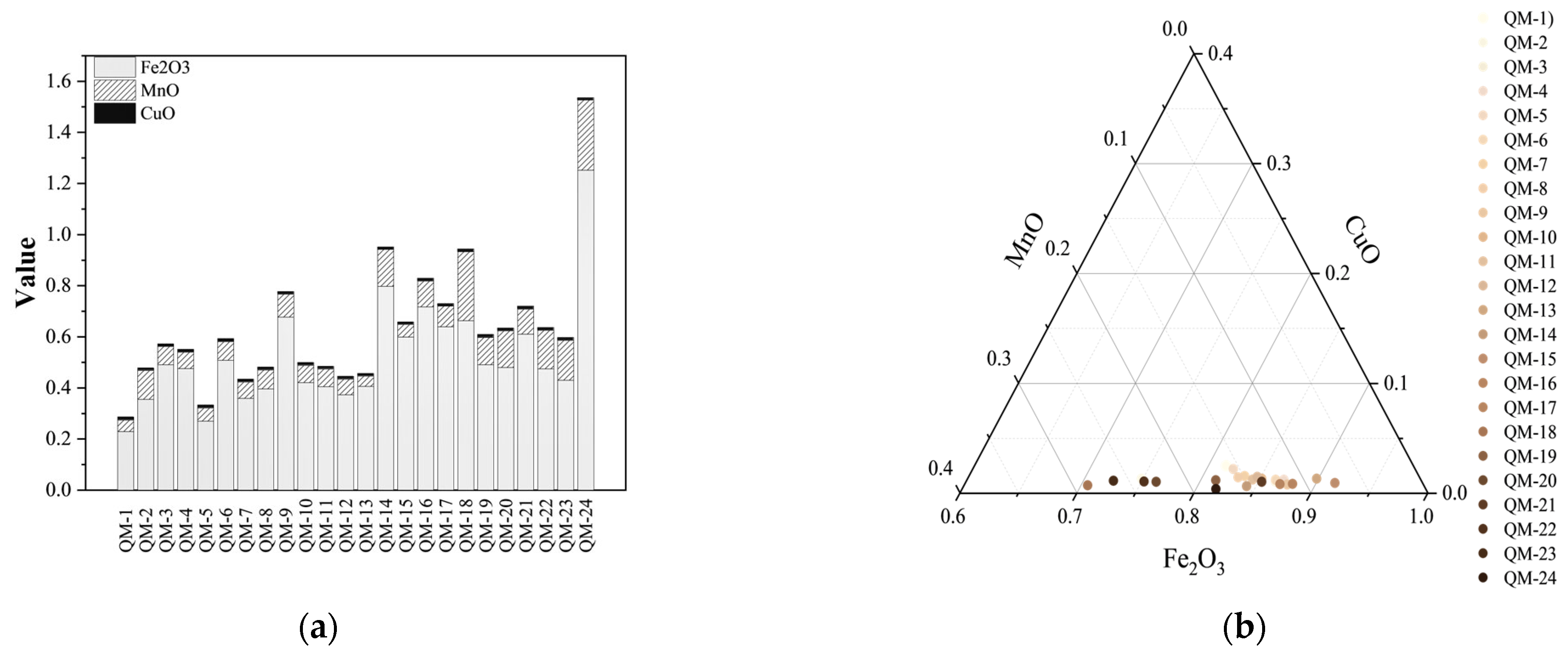
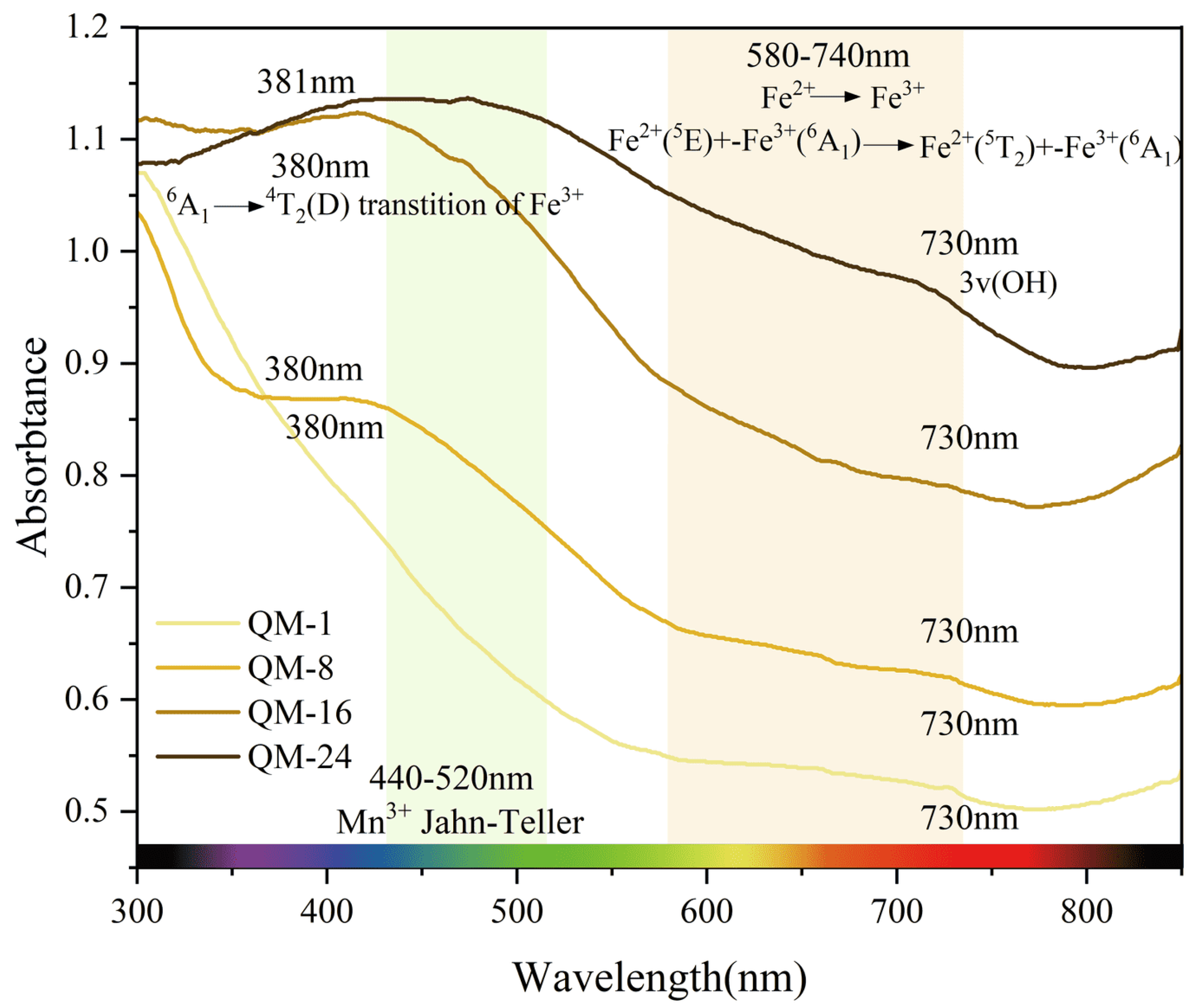
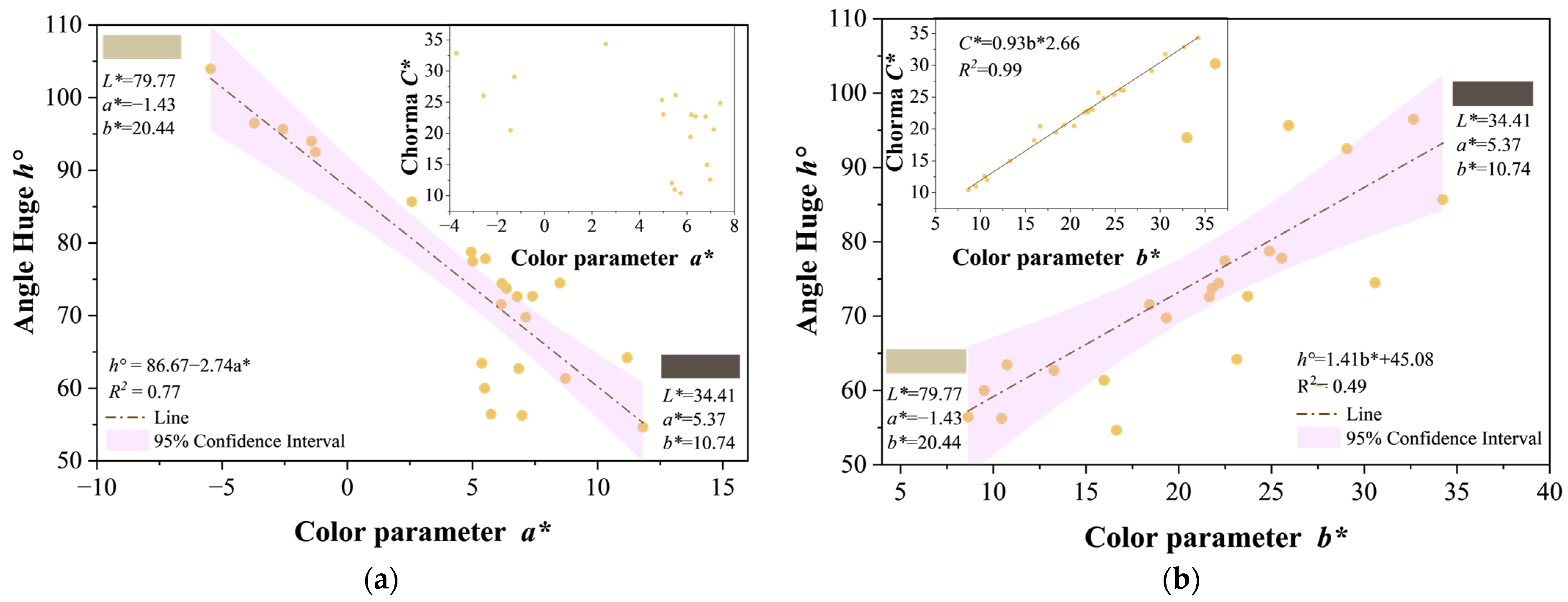
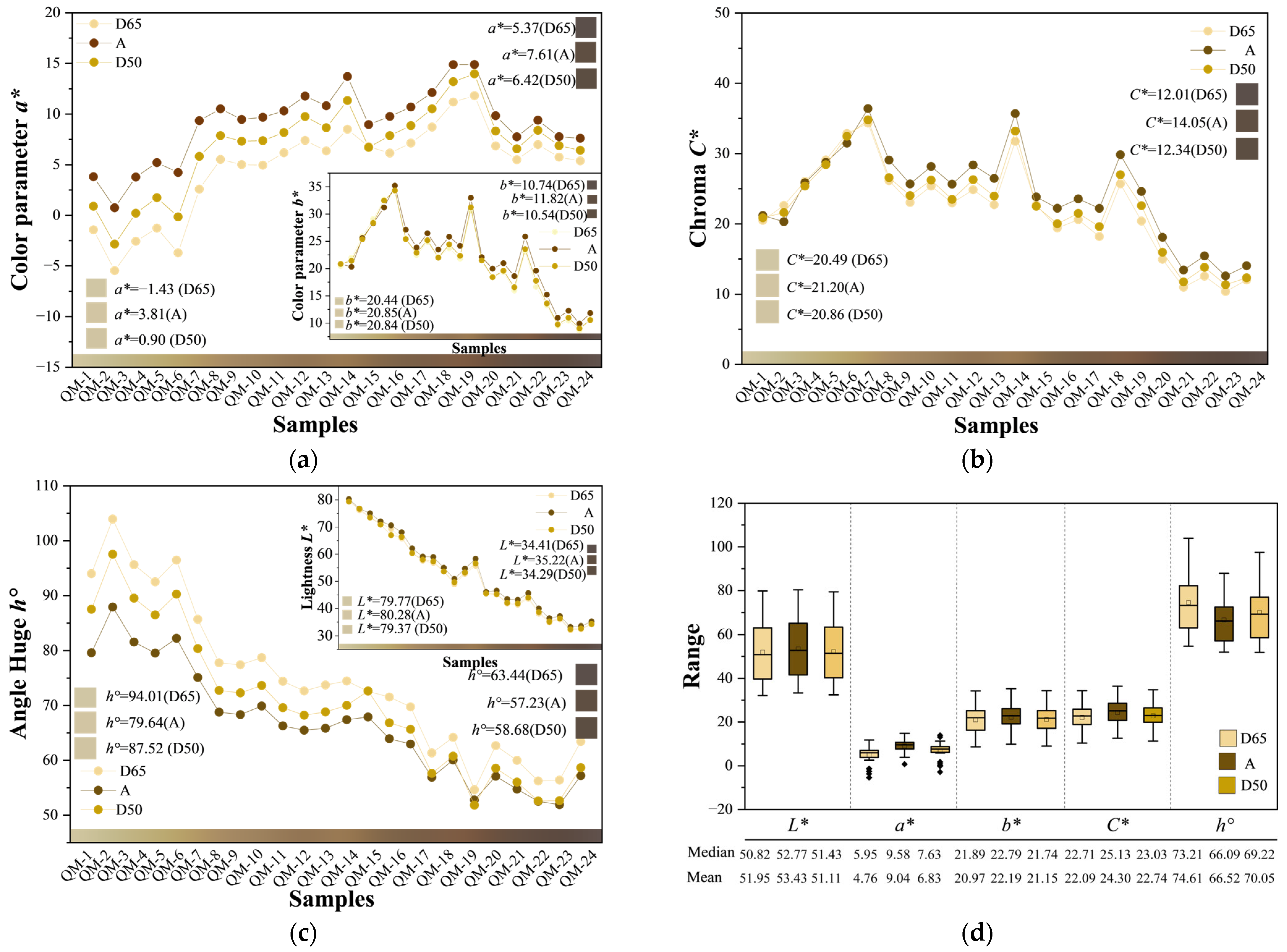
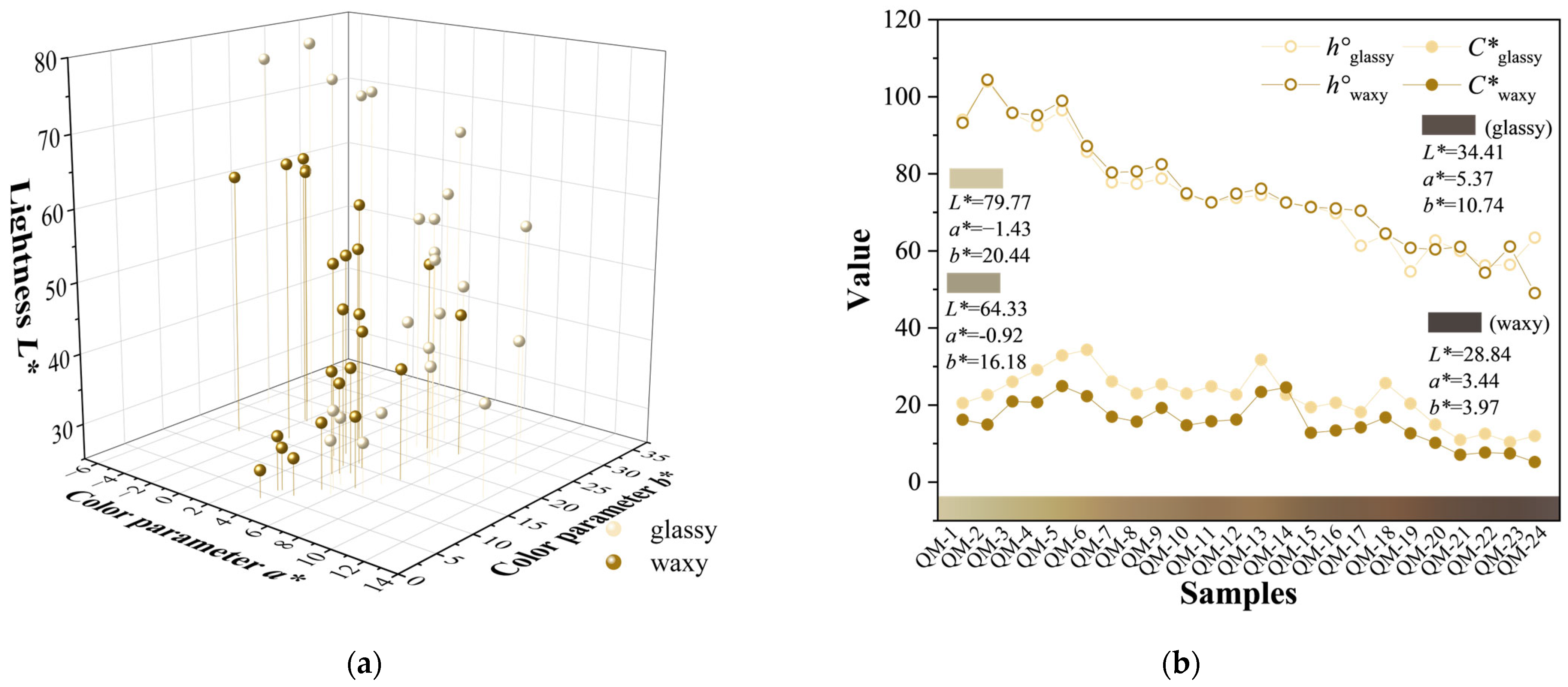
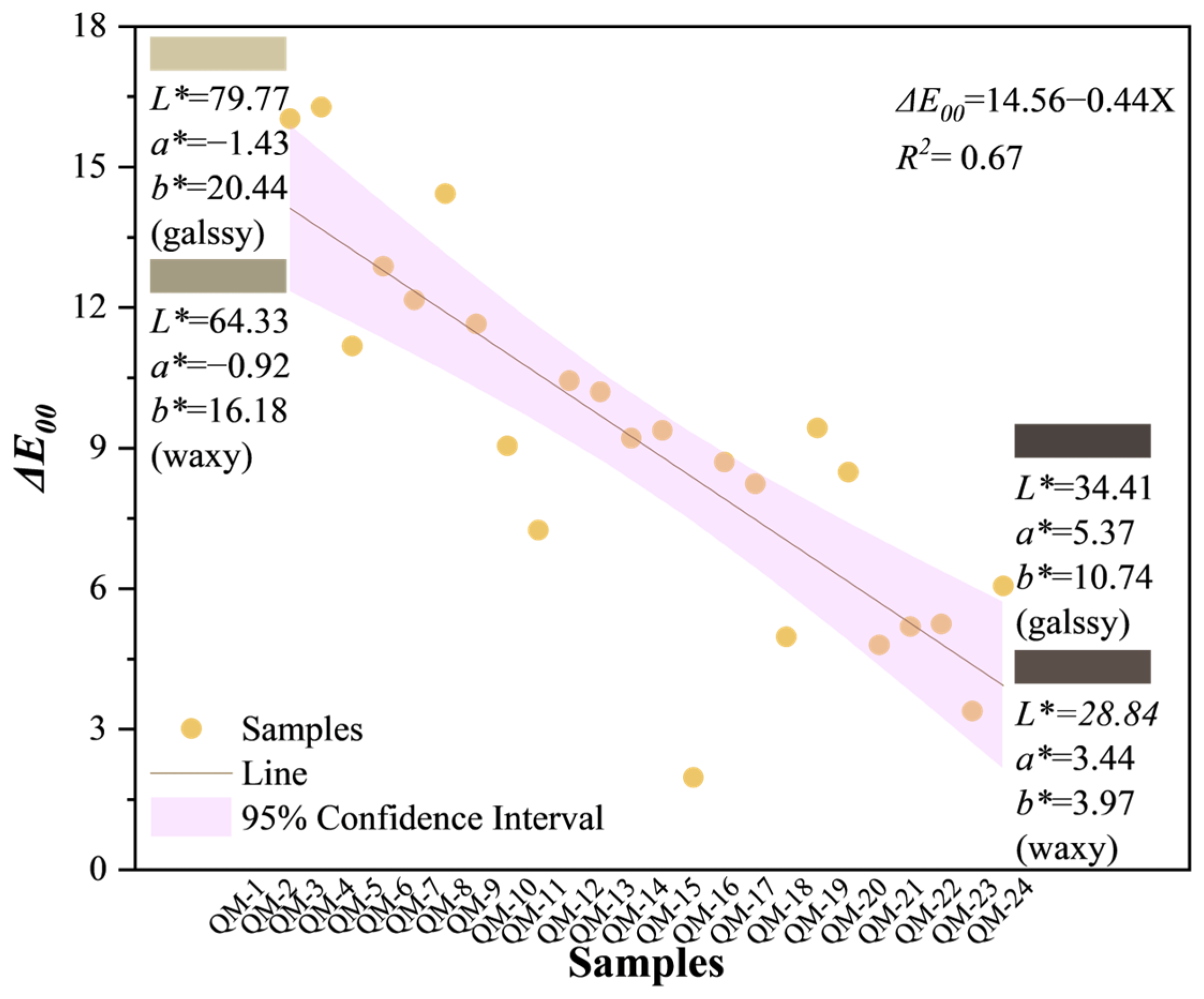
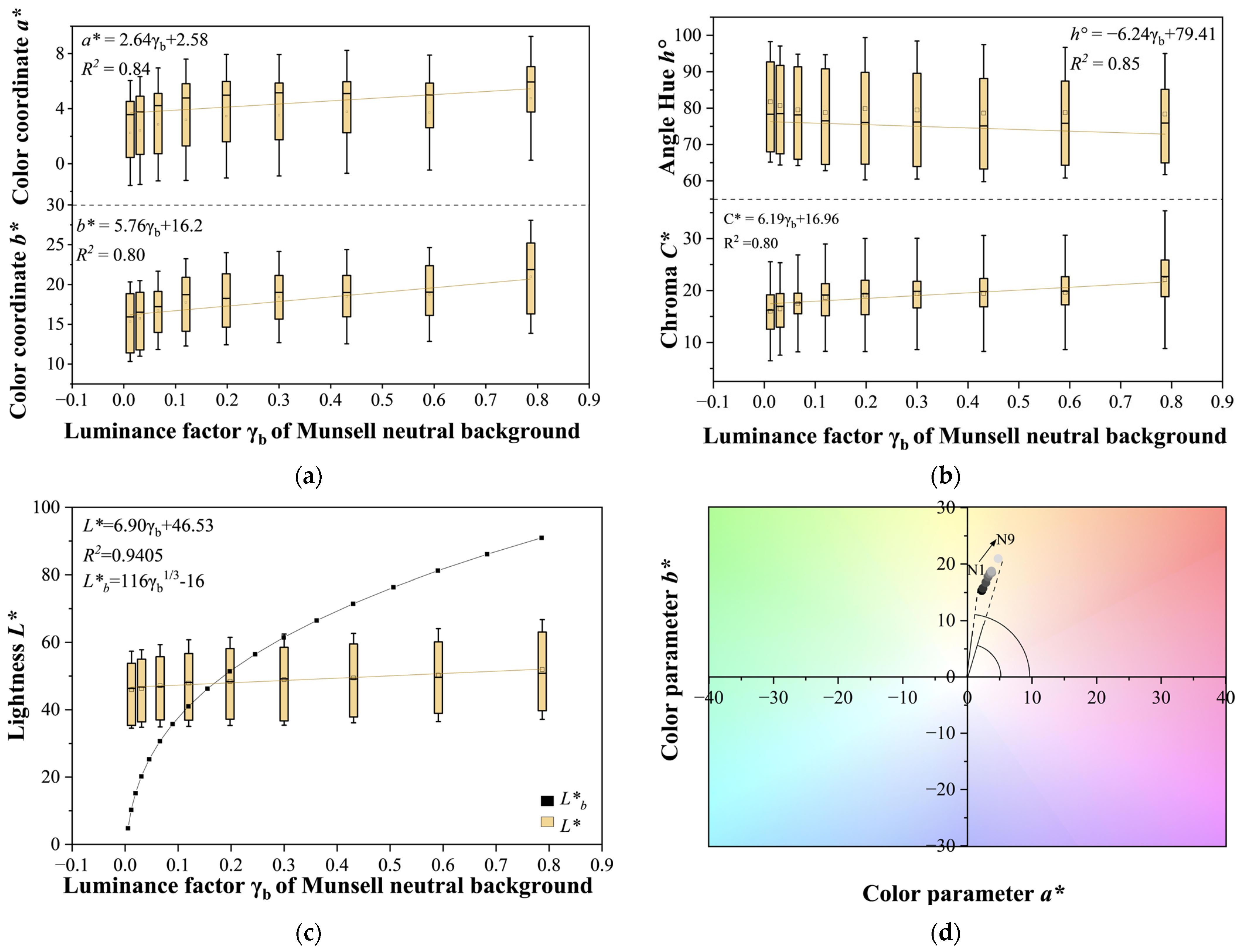
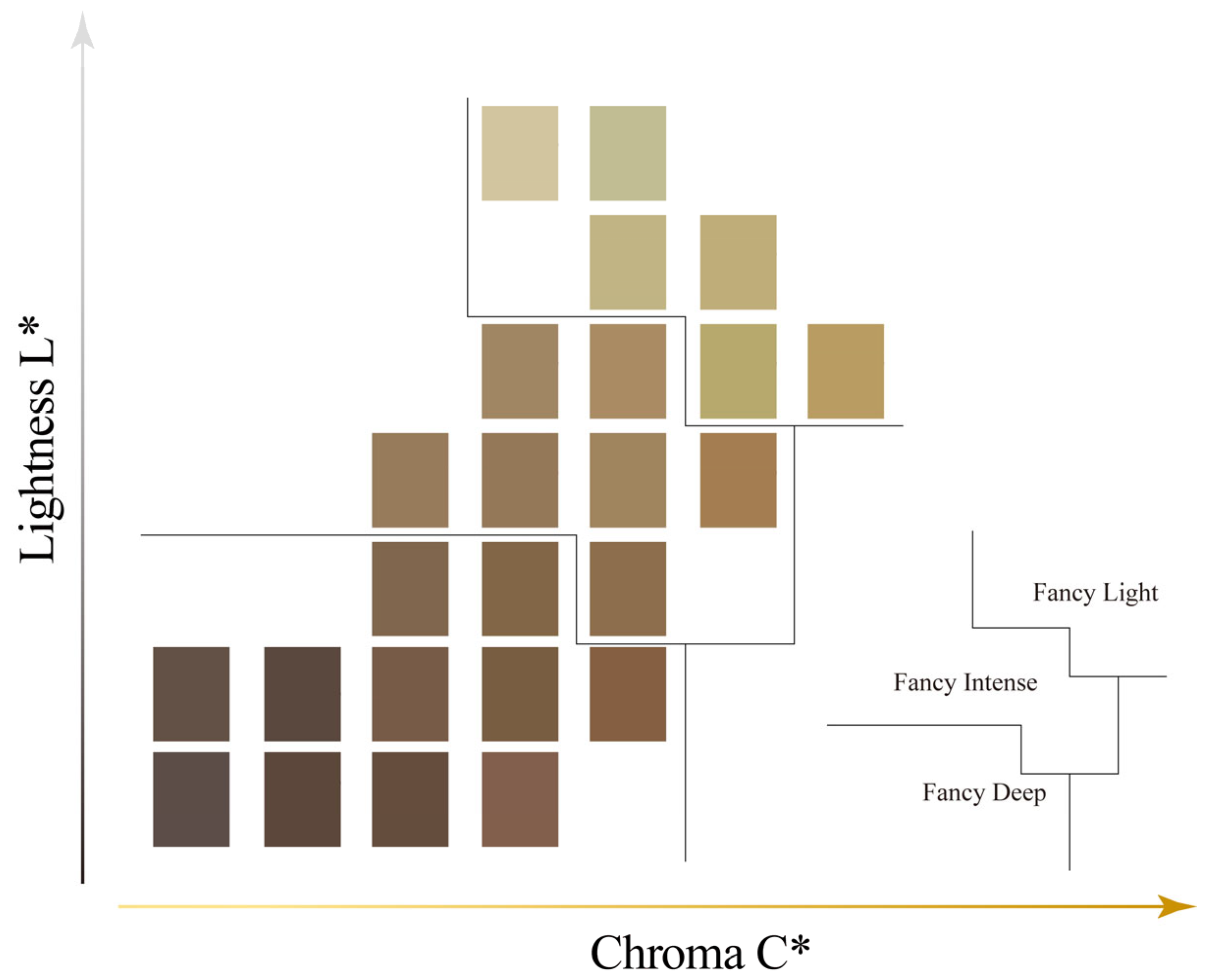
| Sample | SiO2 | MgO | CaO | Fe2O3 | K2O | MnO | CuO | NiO | ZnO | Total |
|---|---|---|---|---|---|---|---|---|---|---|
| QM-1 | 57.82 | 25.80 | 15.90 | 0.23 | 0.19 | 0.05 | 0.01 | 0.01 | 0.00 | 100.00 |
| QM-2 | 60.95 | 24.09 | 14.32 | 0.36 | 0.08 | 0.11 | 0.01 | 0.00 | 0.08 | 100.00 |
| QM-3 | 58.69 | 25.21 | 15.42 | 0.49 | 0.10 | 0.07 | 0.01 | 0.01 | 0.01 | 100.00 |
| QM-4 | 59.50 | 24.36 | 15.46 | 0.48 | 0.12 | 0.06 | 0.01 | 0.00 | 0.01 | 100.00 |
| QM-5 | 59.30 | 25.09 | 15.15 | 0.27 | 0.11 | 0.05 | 0.01 | 0.00 | 0.01 | 100.00 |
| QM-6 | 58.73 | 24.82 | 15.74 | 0.51 | 0.10 | 0.07 | 0.01 | 0.01 | 0.01 | 100.00 |
| QM-7 | 59.57 | 24.75 | 15.11 | 0.36 | 0.11 | 0.06 | 0.01 | 0.00 | 0.02 | 100.00 |
| QM-8 | 60.94 | 23.49 | 14.93 | 0.40 | 0.13 | 0.07 | 0.01 | 0.01 | 0.03 | 100.00 |
| QM-9 | 58.85 | 25.92 | 13.92 | 0.68 | 0.49 | 0.09 | 0.01 | 0.00 | 0.04 | 100.00 |
| QM-10 | 57.96 | 25.16 | 16.24 | 0.42 | 0.11 | 0.07 | 0.01 | 0.00 | 0.07 | 100.04 |
| QM-11 | 57.81 | 26.45 | 15.10 | 0.41 | 0.12 | 0.07 | 0.01 | 0.01 | 0.03 | 100.00 |
| QM-12 | 58.36 | 26.16 | 14.88 | 0.37 | 0.13 | 0.06 | 0.01 | 0.00 | 0.02 | 100.00 |
| QM-13 | 58.51 | 24.29 | 16.74 | 0.41 | 0.00 | 0.04 | 0.01 | 0.00 | 0.00 | 100.00 |
| QM-14 | 57.91 | 25.01 | 15.97 | 0.80 | 0.14 | 0.14 | 0.01 | 0.00 | 0.03 | 100.00 |
| QM-15 | 58.65 | 24.71 | 15.97 | 0.60 | 0.00 | 0.05 | 0.01 | 0.00 | 0.01 | 100.00 |
| QM-16 | 59.33 | 24.69 | 14.97 | 0.72 | 0.16 | 0.10 | 0.01 | 0.00 | 0.03 | 100.00 |
| QM-17 | 59.79 | 24.12 | 15.24 | 0.64 | 0.11 | 0.08 | 0.01 | 0.00 | 0.01 | 100.00 |
| QM-18 | 59.21 | 23.48 | 16.19 | 0.66 | 0.12 | 0.27 | 0.01 | 0.00 | 0.06 | 100.00 |
| QM-19 | 58.01 | 26.13 | 15.15 | 0.49 | 0.08 | 0.11 | 0.01 | 0.00 | 0.02 | 100.00 |
| QM-20 | 57.50 | 25.56 | 16.04 | 0.48 | 0.22 | 0.14 | 0.01 | 0.01 | 0.04 | 100.00 |
| QM-21 | 59.71 | 23.70 | 15.86 | 0.61 | 0.00 | 0.10 | 0.01 | 0.00 | 0.01 | 100.00 |
| QM-22 | 58.95 | 24.00 | 16.17 | 0.48 | 0.21 | 0.15 | 0.01 | 0.00 | 0.04 | 100.00 |
| QM-23 | 59.20 | 24.42 | 15.77 | 0.43 | 0.00 | 0.16 | 0.01 | 0.00 | 0.02 | 100.00 |
| QM-24 | 59.10 | 23.77 | 15.44 | 1.25 | 0.09 | 0.28 | 0.01 | 0.00 | 0.06 | 100.00 |
| Wavelength (nm) | Assignment |
|---|---|
| 380 | The 6A1 → 4T2(D) transition of Fe3+ |
| 440–520 | The Jahn-Teller effect of Mn3+ |
| 580–740 | Fe2+—Fe3+ charge transfer Fe2+(5T2) + Fe3+(6A1) → Fe2+ (5E) +Fe3+(6A1) |
| 730 | 3v(OH) |
| Color Parameters | df | Mean Square | F | p |
|---|---|---|---|---|
| L* | 2 | 31.4853 | 0.07273 | 0.92992 |
| a* | 2 | 220.12636 | 6.60562 | 0.00237 |
| b* | 2 | 20.95009 | 0.21658 | 0.80581 |
| C* | 2 | 61.5063 | 0.72607 | 0.48746 |
| h° | 2 | 788.6503 | 2.50092 | 0.08942 |
| Samples | Color Parameter (Glassy) | Simulated Color | Color Parameter (Waxy) | Simulated Color | ∆E00 | ||||
|---|---|---|---|---|---|---|---|---|---|
| L* | a* | b* | L* | a* | b* | ||||
| QM-1 | 79.77 | −1.43 | 20.44 |  | 64.33 | −0.92 | 16.18 |  | 16.03 |
| QM-2 | 76.18 | −5.46 | 21.97 |  | 61.84 | −3.71 | 14.47 |  | 16.28 |
| QM-3 | 73.42 | −2.57 | 25.92 |  | 63.47 | −2.12 | 20.85 |  | 11.18 |
| QM-4 | 71.42 | −1.27 | 29.07 |  | 61.69 | −1.88 | 20.65 |  | 12.88 |
| QM-5 | 69.31 | −3.71 | 32.66 |  | 60.19 | −3.87 | 24.62 |  | 12.16 |
| QM-6 | 65.79 | 2.58 | 34.23 |  | 57.87 | 1.10 | 22.26 |  | 14.43 |
| QM-7 | 60.36 | 5.52 | 25.55 |  | 53.24 | 2.84 | 16.72 |  | 11.65 |
| QM-8 | 57.56 | 5.01 | 22.49 |  | 52.34 | 2.56 | 15.52 |  | 9.05 |
| QM-9 | 56.82 | 4.95 | 24.89 |  | 53.22 | 2.52 | 19.09 |  | 7.25 |
| QM-10 | 53.56 | 6.18 | 22.15 |  | 47.13 | 3.84 | 14.26 |  | 10.44 |
| QM-11 | 48.91 | 7.40 | 23.72 |  | 44.25 | 4.73 | 15.06 |  | 10.20 |
| QM-12 | 52.72 | 6.36 | 21.81 |  | 46.18 | 4.24 | 15.68 |  | 9.21 |
| QM-13 | 55.72 | 8.49 | 30.59 |  | 51.47 | 5.61 | 22.73 |  | 9.38 |
| QM-14 | 45.55 | 6.79 | 21.65 |  | 45.00 | 7.38 | 23.45 |  | 1.97 |
| QM-15 | 45.12 | 6.15 | 18.43 |  | 39.45 | 4.10 | 12.16 |  | 8.70 |
| QM-16 | 41.76 | 7.13 | 19.33 |  | 37.77 | 4.36 | 12.67 |  | 8.24 |
| QM-17 | 41.39 | 8.72 | 15.97 |  | 39.85 | 4.76 | 13.40 |  | 4.97 |
| QM-18 | 43.60 | 11.18 | 23.13 |  | 40.46 | 7.23 | 15.16 |  | 9.43 |
| QM-19 | 38.03 | 11.81 | 16.64 |  | 34.96 | 6.19 | 11.07 |  | 8.49 |
| QM-20 | 34.96 | 6.85 | 13.27 |  | 34.31 | 5.04 | 8.87 |  | 4.80 |
| QM-21 | 36.00 | 5.49 | 9.51 |  | 32.54 | 3.44 | 6.22 |  | 5.19 |
| QM-22 | 32.13 | 6.98 | 10.45 |  | 30.18 | 4.49 | 6.26 |  | 5.25 |
| QM-23 | 32.42 | 5.74 | 8.65 |  | 30.91 | 3.59 | 6.51 |  | 3.39 |
| QM-24 | 34.41 | 5.37 | 5.37 |  | 28.84 | 3.44 | 3.97 |  | 6.06 |
| Background | N1 | N2 | N3 | N4 | N5 | N6 | N7 | N8 | N9 | |
|---|---|---|---|---|---|---|---|---|---|---|
| γb | 0.0121 | 0.03126 | 0.06555 | 0.12000 | 0.19770 | 0.30050 | 0.43060 | 0.59100 | 0.78660 | |
| L*b | 10.63 | 20.56 | 30.76 | 41.22 | 51.58 | 61.70 | 71.60 | 81.35 | 91.08 | |
| Photos |  | |||||||||
| Color parameter | L* | 45.96 | 46.29 | 47.14 | 47.92 | 48.42 | 48.95 | 49.41 | 50.26 | 51.95 |
| a* | 2.23 | 2.41 | 2.86 | 3.20 | 3.46 | 3.53 | 3.78 | 3.72 | 4.76 | |
| b* | 15.33 | 15.74 | 16.75 | 17.75 | 18.21 | 18.43 | 18.47 | 18.75 | 20.97 | |
| ∆E00 | N1 | - | - | - | - | - | - | - | - | - |
| N2 | 0.56 | - | - | - | - | - | - | - | - | |
| N3 | 1.95 | 1.39 | - | - | - | - | - | - | - | |
| N4 | 3.26 | 2.71 | 1.31 | - | - | - | - | - | - | |
| N5 | 3.98 | 3.43 | 2.03 | 0.73 | - | - | - | - | - | |
| N6 | 4.50 | 3.95 | 2.56 | 1.28 | 0.58 | - | - | - | - | |
| N7 | 4.92 | 4.37 | 2.99 | 1.75 | 1.07 | 0.53 | - | - | - | |
| N8 | 5.69 | 5.15 | 3.80 | 2.60 | 1.94 | 1.36 | 0.90 | - | - | |
| N9 | 8.66 | 8.11 | 6.73 | 5.44 | 4.72 | 4.17 | 3.74 | 3.02 | - | |
| Color Parameter | Clustering | Error | F | p | ||
|---|---|---|---|---|---|---|
| Mean Square | Df | Mean Square | Df | |||
| L* | 2289.805 | 2 | 21.827 | 21 | 104.908 | <0.001 |
| a* | 184.660 | 2 | 4.552 | 21 | 40.565 | <0.001 |
| b* | 345.726 | 2 | 22.335 | 21 | 15.479 | <0.001 |
| Cluster Center | Quantity | L* Lightness | a* Color Parameter | b* Color Parameter | Simulated Color |
|---|---|---|---|---|---|
| Group 1 | 6 | 72.65 | −1.98 | 27.38 |  |
| Group 2 | 11 | 38.67 | 7.47 | 15.25 |  |
| Group 3 | 7 | 55.09 | 6.27 | 24.46 |  |
Disclaimer/Publisher’s Note: The statements, opinions and data contained in all publications are solely those of the individual author(s) and contributor(s) and not of MDPI and/or the editor(s). MDPI and/or the editor(s) disclaim responsibility for any injury to people or property resulting from any ideas, methods, instructions or products referred to in the content. |
© 2025 by the authors. Licensee MDPI, Basel, Switzerland. This article is an open access article distributed under the terms and conditions of the Creative Commons Attribution (CC BY) license (https://creativecommons.org/licenses/by/4.0/).
Share and Cite
Liu, K.; Tang, J.; Guo, Y. Colorimetric Properties and Classification of “Tang yu”. Crystals 2025, 15, 817. https://doi.org/10.3390/cryst15090817
Liu K, Tang J, Guo Y. Colorimetric Properties and Classification of “Tang yu”. Crystals. 2025; 15(9):817. https://doi.org/10.3390/cryst15090817
Chicago/Turabian StyleLiu, Kaichao, Jun Tang, and Ying Guo. 2025. "Colorimetric Properties and Classification of “Tang yu”" Crystals 15, no. 9: 817. https://doi.org/10.3390/cryst15090817
APA StyleLiu, K., Tang, J., & Guo, Y. (2025). Colorimetric Properties and Classification of “Tang yu”. Crystals, 15(9), 817. https://doi.org/10.3390/cryst15090817







